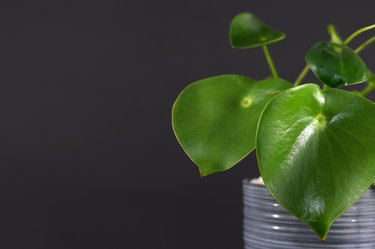
Teardrop plants (Peperomia polybotrya, winter hardy in USDA zones 10 and 11) are easy to care for and are visually pleasing indoor plants, ideal for the easygoing or forgetful home gardener. Teardrop plants, sometimes called baby rubber plants, originate from tropical forests. More specifically, they are native to the forests of Columbia and Peru. There are varieties with different leaf shapes, sizes and coloration, but care is generally fairly similar across varieties.
Teardrop Plant Care
Video of the Day
While the different species of Peperomia can have wildly differing appearances, the teardrop plant is identified by the rounded, heart-shaped leaves that are thick and fleshy. At full maturity, they grow between 8 and 12 inches tall and no more than 2 feet across. These small plants aren't known for their blossoms, and their flowers mostly resemble a green cluster of soft, bushy spikes. They are more prized for their foliage than their flowers.
Video of the Day
This resilient plant stores a good amount of water in its fleshy stems and leaves, which helps it survive drought conditions. This means that you can leave them alone while on vacation with no worries. It also means that you can easily overwater these plants and leave them waterlogged, leading to root rot.
You can try a "soak and dry" method for watering this plant, wherein you wait until the top inch of soil is completely dry and then saturate the soil, being sure to allow the soil to drain after saturation. The teardrop plant prefers a humid environment, which you can provide by resting the planter on top of a tray of pebbles or rocks half submerged in water. As the rocks absorb warmth from the sun and environment, the water will evaporate, creating localized humidity that won't affect the room's overall humidity.
Additional Teardrop Plant Care Tips
When caring for your teardrop flower plant, you should prune lower stems, leaving the top leaf to receive as much nutrition from the plant as possible, but they are slow-growing plants, so you shouldn't need to prune it very often. The teardrop plant tolerates pruning well, so don't worry too much about shocking it when removing dead or wilting leaves.
The peperomia prefers lots of indirect light but can survive even in dim conditions. As a caution, dim light will slow your plant's growth and may result in your peperomia becoming leggy as it stretches for better access to light.
If you need to repot your plant, which should only be every two to three years to prevent the soil from becoming too compact, you can do so without much fuss. After gently removing your plant from its pot, carefully remove as much of the soil from around the roots as possible without damaging them. Once you have your teardrop plant in its new planter, gently pack the new potting mixture around the roots without compressing it too tightly. Water your newly potted foliage and relax.
Growing Teardrop Plants Indoors
These plants are completely nontoxic to humans and animals, so you don't have to worry about your pets or children taking small nibbles. These greens don't really taste that good, so you probably won't have that problem more than once or twice. Of course, it's always best to keep plants out of the reach of children and pets.
Because these plants are so low maintenance and grow well in indirect light, they are ideal for indoor growth. Whether in a hanging planter, on a desk or adorning a mantle, the teardrop plant will grow steadily.